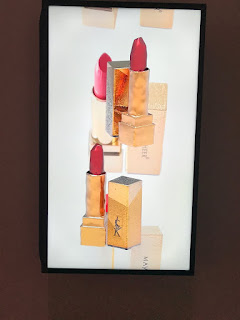Event blog - Eco-Centric Art+Science
The event that I attended was ECO-CENTRIC ART + SCIENCE: Prophesies and Predictions.
It is an open-mic marathon symposium featuring
artist and author Linda Weintraub, nanoscientist James Gimzewski, evolutionary
biologist Charles Taylor, environmentalist and author Ursula Heise, curator
Sophie Lamparter, nano-toxicologist Olivia Osborne, and media art graduate
students David Ertel Symrin Chawla.
Art|Sci artist-in-residence Linda Weintraub’s forthcoming book: “WHAT’S NEXT? Eco Materialism and Contemporary Art” provides the opportunity for professors and students from multiple academic disciplines to share their predictions of the way ecology will impact the theory, practice, insight, re-evaluation, or revision in their discipline in the coming years.
Linda Weintraub’s speech is
mainly focus on how to put the human body in the context of the material world.
She believes that we should integrate ourselves physically into the material
world and the environment, to feel them with our hands and other feeling, so
that we could truly care about the ecosystem. She introduced the term
“neo-materialism”. Neo-materialism explores the meaning of the world of
commodities, and reintroduces various notions of dialectical materialism into
the conversation on the subjectivity and vitalism of things. She introduced a
quote that express an enlightening ideology, “Ideas of health are dominated by
medical, pharmaceutical, individualized, atomized concepts. We need a “participatory
politics that reframes health issues as environmental issues and environmental
issues as health issues.” As an example, Linda talked about Jae Rhim Lee, who
is eager to make contribution to the environment. She worked on a project to
use human urine as fertilizer for plants. She altered her diet so that her
urine consisted of the right proportion of elements to fertilize plants. She
developed a system to grow cabbage using her own urine and made the cabbage
into kimchi. The kimchi turned out to be very delicious.
Linda Weintraub’s talk is very
enlightening because she presented easy but really important interaction
between human and the material world. Human should have the awareness to feel
the environment in person, establish a connection with the nature and
contribute to the environment with simple but effective movements. The
interaction would be very effective in engaging people in environmental
conservation.
Another speaker that catches my
attention is Ursula Heise. She is a professor at UCLA at the Institute of the
Environment and Sustainability. Her speech is focused on animal conservation. She
noted that there may be a mass extinction because of human behavior. In order
to raise awareness on animal conservation, there comes lots of literature on
the theme, whereby there is a common logic of these biodiversity narratives.
Most of the narratives uses “charismatic megafauna”, which means large animal
species which are appealing and popular, such as panda, elephant and polar
bears etc. Using these animal icons help to achieve more widespread animal
conservation behavior. Also, she highlighted biodiversity conservation is
ultimately be done by analogy to culture identity and values. With literatures
that draw analogy between the death of animals and the lost of our loved ones,
and the justice behind protecting other species, people is more likely to be
touched and join in the course to protect animals.
Heise’s speech makes me aware of
the literature appearance in animal conservation. The uses of anthropomorphic
is always appearing in literature but I have not linked it with promoting
animal conservation. The way Heise highlights the literary policy formalize my knowledge on this theme.
In conclusion, the talks are very informative and enlightening. I enjoyed myself and learned a lot about environmental conservation and the uses of art and science in the course.
Reference:
1.
Brinded, Lianna. World Economic Forum.
"This is how robots will change the future of work".
https://www.weforum.org/agenda/2017/01/heres-how-robots-are-going-to-change-employment
2.
Kelly, Kevin. “The Third Culture”. Science
13 February 1998: Vol. 279 no. 5353 pp. 992-993. Web.
3.
Benjamin, Walter. “The Work of Art in the
Age of Mechanical Reproduction”. London: Penguin, 2008. Print.
4.
Snow, C.P. “Two Cultures and the Scientific
Revolution”. New York: Cambridge UP, 1959. Print.
5.
Violino, Bob. ZedNet. "The future of
robotics: 10 predictions for 2017 and beyond".
http://www.zdnet.com/article/the-future-of-robotics/
6.
Squatriglia, Chuck. Wired. "How Nissan
Made Its 'Polar Bear' Leaf Ad".
https://www.wired.com/2010/09/video-how-nissan-made-its-cute-polar-bear-leaf-ad/







Comments
Post a Comment